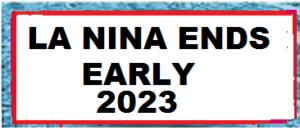On the second Thursday of every month, NOAA issues its analysis of the status of ENSO. This includes determining the Alert System Status. NOAA describes their Report as “ENSO Alert System Status: Final La Niña Advisory”
If you read the fine print you can see that we are still in the transition. We have left La Niña but are not fully into ENSO Neutral. The rules seem to be that when you no longer meet the criteria for La Nina or El Nino, you are in ENSO Neutral even if the atmosphere has not fully transitioned to ENSO Neutral. This makes a lot of sense since in general, the atmosphere reacts to the ocean conditions rather than the ocean reacting to the atmosphere but it is not as clear cut as what I have just stated. But typically the reaction of the atmosphere lags the change in the ocean condition and the change in the atmosphere confirms that the change in the ocean will impact weather patterns.
Some of the models suggest a rapid change to El Nino during or after the Summer. It seems likely that the ENSO Neutral Phase will at the very least have an El Nino bias.
We have published a shorter version of our usual article since there is little disagreement that we are transitioning away from La Nina. It is also a bit too early to be confident that we will have an El Nino next winter. We need to get past the Spring Prediction Barrier (SPB) to be confident about having an El Nino soon.
The article includes a very interesting post from the ENSO Blog. It is worth reading. Among other things, it discusses the situation off of Peru which might increase the chances for an El Nino but it also is a warning as to some potentially problematic weather conditions for Peru.







